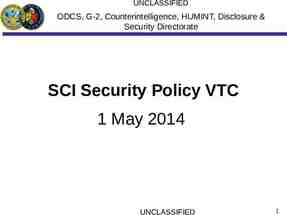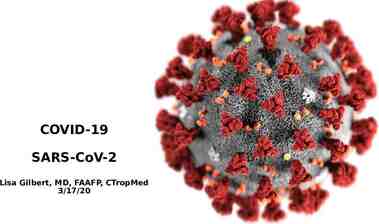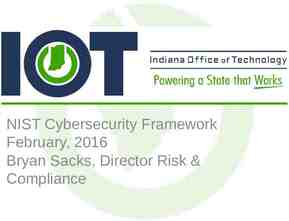Drexel University Conduct Board Training The Office of Equality
85 Slides7.92 MB

Drexel University Conduct Board Training The Office of Equality & Diversity October 2020

WHY ARE WE HERE? 2

Introduction & Agenda Agenda: Prework: OED overview Prework: history of Title IX Dynamics of Title IX Grievance Process Perspectives and other considerations Dynamics of trauma and sexual misconduct Investigations and investigative reports 3

Introduction & Agenda Agenda continued: Preparing for and Conducting Hearings Goals of CB process Preparing Hearing to adjudicate practices Decision-making and Outcomes Assessing credibility Deliberation techniques Burden of proof Written rationales Sanctioning and appeals 4

Don’t forget to Take care of yourself Listen to each other Learn from each other Question authority Ask hard questions Ask “easy” questions Don’t let it go 5

Backgrou nd 6

Background: What is Title IX/VAWA? 7

Background: What is Title IX/VAWA? What conduct fall under Title IX/VAWA? Sex or Gender-based harassment/discrimination Sexual Assault Stalking Dating Violence Domestic Violence Retaliation Sexual Exploitation Non-physcial Intimate Partner Violence Sex Offenses against a person under the age of 18 8

Background: What Does Title IX/VAWA require? Respond promptly in a manner that is not deliberately indifferent Treat complainants and respondents equitably Offer supportive measures upon actual knowledge Pursue investigation and adjudication in response to a formal complaint Provide written notice upon receipt of a formal complaint Dismiss a formal complaint if required Recipient school responsible for gathering evidence Provide equal opportunity for parties to present witnesses and evidence 9

Background: What Does Title IX/VAWA require? Provide evidence to parties and their advisors to review Prepare an investigative report to fairly summarize relevant evidence and send to party at least 10 days prior to hearing Provide for a live hearing Permit each party’s advisor to ask questions of and cross-examine the other party and witnesses Provide advisor at no cost to conduct crossexamination, if needed Cannot rely on any statement from a party or witness who is not subjected to cross-examination Issue written determination Offer both parties the right to appeal both a dismissal of 10 a formal complaint and a determination

Dynamics of the Title IX Grievance Process 11

Dynamics of the Title IX Grievance Process Complainants Shame Unsure about what happened Everyone knows Isolation Labeling Effect

Dynamics of the Title IX Grievance Process Respondents It’s all on the line How safe is the truth? How dangerous is a lie? Crisis of the self Everyone knows Shame 13

Dynamics of the Title IX Grievance Process Witnesses Pick a side Shame over lack of "inaction" Scared to get in trouble 14

Dynamics of the Title IX Grievance Process What about Culture Religion Sexual Orientation Gender Identity Race Mental Health 15

Dynamics of the Title IX Grievance Process Sam is an 18-year-old freshman from Philadelphia, PA, attending Drexel on a scholarship (without which Sam would not be able to afford school). No one else in Sam’s family has ever been to college. Sam’s mom is so proud of Sam that every time they talk on the phone, she jokes about how all of the neighbors are tired of hearing her bragging about her future engineer and says that she “always knew” Sam would be the one to “make the family proud.” Sam is finding college coursework to be much more difficult than at public high school and is already struggling to keep up. Sam goes to a party with friends on a Friday, drinks way more than ever before, and is sexually assaulted by a stranger. Ashamed, scared, and unable to concentrate, Sam fails two midterm exams and is unable to submit an important project on time the following week. 16

Dynamics of the Title IX Grievance Process You are Taylor, but instead of having experienced a sexual assault yourself, you woke up after night of drinking to find yourself in bed with another student and vaguely remember having consensual sex the night before. You don’t remember exactly what happened, but soon start hearing rumors amongst your social group that the other student is claiming that you sexually assaulted them while they were too drunk to consent. You are confused and embarrassed, and soon receive an e-mail from the Title IX Coordinator asking to meet in their office to discuss an incident that had been reported. 17

Dynamics of the Title IX Grievance Process You are a 20-year-old sophomore and have received an e-mail from the College’s Title IX Coordinator stating that they believe that you “may have information relevant” to a “report of an incident that may fall under the University’s Sexual Harassment and Misconduct Policy.” The e-mail assures you that you have not been accused of wrongdoing, but that you are welcome to be accompanied to the meeting by an “advisor of choice.” 18

Dynamics of the Title IX Grievance Process The Dynamics of Sexual Assault, Harassment, Dating Violence, Domestic Violence, and Stalking 19

Statistics Sexual Misconduct is a longstanding problem on campuses nationwide 1 in 5 women (1 in 10 by partner) 1 in 16 men (1 in 45 by partner) 8 out of 10 are acquaintances 90% do not report What about Stalking? Dating/Domestic Violence? What about impact? Source: Nat’l Sexual Violence Resource Center, 2015 20

Statistics and their limits BEWARE 21

Neurobiology of Trauma (and limitations) What is Trauma? Deeply disturbing or distressing experience Both a psychological and physiological response Trauma is interpreted by the body as a lifethreatening experience. 22

Neurobiology of Trauma (and limitations) fight, flight, freeze energy availability physical pain reduction emotional pain reduction 23

Neurobiology of Trauma (and limitations) The Effects Flat affect (or opposite) Fragmented/incomplete memory Confusion and difficulty remembering Changing or inconsistent emotions Counter-intuitive response 24

Neurobiology of Trauma (and limitations) Common Issues and Coping Mechanisms Delayed reporting Subsequent consensual interactions Ongoing contact Inconsistent disclosures Use of protection Drugs and alcohol Everything is fine until it isn’t. 25

Neurobiology of Trauma (and limitations) Limitations Use knowledge of trauma responses to suspend disbelief, not as “proof” or as substitute for sufficient evidence Recognize possible effects on accused, as well Trauma of allegation Trauma of IPV? Stalking? Harassment? Ongoing stress impacting memory? Effects on demeanor/affect 26

Dynamics of the Title IX Grievance Process Investigations and Investigative Reports

Investigations– Process Report Initial Assessment by University/Title IX Coordinator Supportive Measures Alternative Resolution or Investigation & Adjudication Formal Complaint Preliminary Inquiry Investigation Conduct/ Adjudication (If possible violation is revealed) Remedies & Sanctions and Appeals 28

Investigations– Purpose & Scope Fact Gathering vs. Fact Finding Investigator as info coordinator – Asks all the questions Complainant, Respondent, Witnesses – Identifies all the evidence Physical, electronic, documentary Examples: Medical records; text messages; social media; pictures 29

Investigations– Purpose & Scope Investigative Reports & Investigator as scribe – Documents procedural steps as well as substantive info – Some gatekeeping function, but not overly restrictive – As comprehensive as possible Closes important loops Notes evidence obtained and not obtained (and why) – Reviewed by parties for comment and feedback 30

Preparing for and Conducting Hearings 31

Goals of the CB Process Provide a fair and transparent mechanism for assessing complaints and determining responsibility for alleged misconduct Ensuring that all parties have a fair opportunity to provide and respond to information Process- not punitive Minimize Last “transaction costs” to all parties line of defense. 32

Preparing to Adjudicate Beware of conflicts Check your bias Identify and anticipate issues Scrutinize investigative materials What is there, what isn’t there (and why)? What else do I need to know? Evidentiary issues Completeness (medical records, text convos, etc.) Equitable Weight access 33

Preparing to Adjudicate Reviewing investigation reports Give yourself time Think critically – channel your inner skeptic First read, second read Create timelines, charts, grids, and lists Scrutinize attachments/exhibits Refer to policy elements Need for follow-up or additional steps? Respondent is presumed notresponsible 34

Preparing for and Conductin g Hearings Hearing Practices and Procedures 35

Hearing Practices- Serving Impartially Be objective Be professional You don’t have to be an expert Be an active listener Don’t look for a winner Your job is not to make everybody happy Your job is to make a commonsense evaluation of credibility/responsibility 36

Hearing Practices- Serving Impartially Set aside personal biases and prejudices Beware of assumptions about how someone would/should behave Don’t project morals Mind your demeanor Mind your emotions Be polite and respectful to parties, witnesses, and advisors (even if they don’t reciprocate) Maintain appropriate sensitivity You represent the University and the37 process

Hearing Practices Use the tools you already have Respect and decency Fundamental knowledge of human behavior Common sense, sound judgment Understanding of campus setting and context 38

Hearing Procedures A hearing will generally proceed as follows: Introductions of all attendees Overview of investigation by Investigator Questions posed to Investigator by Advisors and Adjudicator/Conduct Board Brief introductory remarks from the Complainant Brief introductory remarks from the Respondent Questions posed to Complainant by Respondent’s Advisor and Adjudicator/Conduct Board Questions posed to Respondent by Complainant’s Advisor and Adjudicator/Conduct Board Questions posed to Complainant’s Witnesses by Respondent’s Advisor and Adjudicator/Conduct Board Questions posed to Respondent’s Witnesses by Complainant’s Advisor and Adjudicator/Conduct Board Short recess Brief concluding remarks by Complainant Brief concluding remarks by Respondent 39

Preparing for and Conducting Hearings Evidentiary Issues During Hearings 40

Evidentiary Issues During Hearings Types of evidence – Investigative report (primary) – Testimonial (live) – Documentary evidence Texts, e-mails, social media Medical records – Physical evidence Direct vs. circumstantial evidence What about “hearsay?” 41

Evidentiary Issues During Hearings Relevance and perspectives Privileged information and records Prior sexual history (rape shield) Prior or subsequent misconduct "Directly related" evidence "Character" evidence 42

Evidentiary Issues During Hearings- Relevance "Relevant" evidence/questions - any questions and evidence that tend to make an allegation of sexual harassment or misconduct more or less likely to be true. Relevant evidence includes both inculpatory and exculpatory evidence. Relevant evidence may NOT include: Privileged information and records Prior sexual history 43

Evidentiary Issues During Hearings- Privileged Information Information protected under a legally recognized privilege cannot be sought, obtained, submitted, relied upon, or asked about unless: the person holding the privilege waives the privilege with voluntary, written consent Examples: Medical records or information Mental health records or information Attorney-client privileged communication and documents 44

Evidentiary Issues During Hearings- Sexual History Evidence and questions about the Complainant’s sexual predisposition or prior sexual behavior are not permitted unless: o They are offered to prove that someone other than the Respondent committed the conduct alleged by the Complainant, or o They concern specific incidents of the Complainant’s prior sexual behavior with respect to the Respondent and are offered to prove consent. 45

Evidentiary Issues During Hearings- Prior or Subsequent Misconduct Evidence of a pattern of inappropriate behavior by a Respondent is permissible so long as it is judged for relevance like any other evidence Prior or subsequent conduct may be relevant to demonstrate: Intent, knowledge, or state of mind Motive Opportunity Lack of mistake Pattern Identity 46

Evidentiary Issues During Hearings- Directly Related “Directly related” evidence may be broader than “relevant” evidence Therefore some evidence may be redacted in the investigative report or documents Directly Related Directly Related and Relevant 47

Evidentiary Issues During Hearings- Character Cannot exclude Character evidence Presumption of non-responsibility 48

Evidentiary Issues During Hearings Expect the unexpected What about new information? Contested Evidence – Try to address in advance – Can you unring the bell? 49

Evidentiary Issues During Hearings What if we’re stuck? – The Board has discretion – Start with policy for answers and guidance – Ask questions to understand positions/challenges – Take a break! – Do you have to decide? – Use your best judgment, rooted in policy and fairness – Explain rationale and preserve issue Reference in rationale, if needed 50

Preparing for and Conducting Hearings Questioning During Hearings 51

Questioning During Hearings Evaluating and posing questions to/from the parties – Parties’ chance/right to pose questions – Review question for relevance & appropriateness – Build in pause – Allow time between question being asked and answer given to allow Conduct Board to review question, determine if it is relevant and appropriately worded, and/or should be reworded or not answered at all. – What about redundancy? – What about re-phrasing? 52

Questioning During HearingsCross Examination Conducted by each Party’s Advisor May ask other Party and witnesses relevant questions Must be conducted directly, orally, and in real time by Advisor NEVER by a Party personally Adjudicator/Conduct Board must first determine whether question is relevant and if it not, explain why it is being excluded as irrelevant 53

Questioning During HearingsCross Examination If a party or witness does not submit to crossexamination at the live hearing, you may not rely on any prior statement, either written or oral, of that Party or witness in reaching a Determination Conduct Board will be instructed to disregard and not consider any statements made by someone who does not submit to crossexamination at live hearing A Party’s Advisor may still conduct crossexamination even if the Party to whom they are advising does not appear 54

Scenario The case before the conduct board involves allegations of sexual assault where the complainant testifies that she was unable to consent due to incapacitated from alcohol consumption. Complainant and Witness live together in the same house. In the investigative report, Witness said in her statement that she saw the Complainant and Respondent come home together after a night of drinking at a bar in University City. Witness stated that the Complainant’s clothes were disheveled, her speech was slurred, and she saw the Complainant fall up the stairs as the Complainant and Respondent proceeded to Complainant’s bedroom. Witness’s presence was requested at the hearing, but she did not appear. Witness did not submit to cross-examination. What happens to Witness’s testimony in the55 Investigative Report? What can you, the Conduct Board, consider from this

Scenario The case before the conduct board involves allegations of Dating Violence- physical assault. Both the Complainant and Respondent were interviewed by the Investigator and their statements appear in the Investigative Report. Their presence is requested at the Conduct Board hearing. Complainant does not appear and does not submit to cross-examination. Respondent appears and submits to cross-examination by the Complainant’s Advisor. What happens to Complainant’s statement in the Investigative Report? What happens to the Respondent’s statement in the Investigative Report and testimony from the live hearing? Why does the Complainant’s Advisor still question the Respondent if the Complainant is not present at56the hearing? Does your answer change if it was the Respondent

Questioning During Hearings Question with Purpose – – – – Hear it for yourself (and from the source) Clarify and confirm Identify issues, Close loops Flesh out new info 57

Questioning Technique – Manner Matters! Consider tone, style, and volume Take time to “soften the ground” Listen well and actively Avoid conveying judgment (via phrasing or tone) Let there be silence Project Respect and Support – Non-verbal cues – Mirroring/Checking/Reflecting – Explain process and questions 58

Questioning Techniques 1. Open-ended – Free recall, narrative 2. Focused – Directs attention 3. Multiple Choice – Range of options, but room for flexibility 4. Yes/No – Clarify/confirm discrete issue 5. Leading – Assumes the answer 59

“Hard Questions” Be sensitive but not avoidant Be fair in identifying How to ask – Acknowledge the elephant – Ask permission – Be thoughtful in phrasing – choose right tool for the job – Give time and space 60

Questioning Techniques – Phrasing Can you tell me about What happened next? What did you/he/she/they do when Can you tell me what you mean by Can you help me understand How did is that correct? 61

Questioning Techniques – Phrasing DO NOT ASK: Are you asking us to believe ? So you’re taking antidepressants and had an exam in the morning, but instead of staying home to study you decided to go out drinking? That doesn’t make sense. So while you were assaulting him/her/them (To Complainant) I’m so sorry to have to ask this, but 62 (To Respondent) So while you were [alleged act], did you [action]?

Decision Making and Outcomes 63

Assessing Credibility Evaluations of responsibility often turn on questions of credibility Consent (including withdrawn consent) Wanted/unwanted Incapacitation Intimate Partner Violence Credibility can be assessed based on a variety of factors, including: Demeanor Interest Detail Corroboration Common-Sense 64

Assessing Credibility - Demeanor During/after events underlying case – Sources of info Outcry/Responding witnesses Law enforcement/medical providers Family/friends – Indicators Withdrawn? Distracted? Depressed? Angry? No observed changes? During Hearing 65

Demeanor Evidence – Beware! Be careful about assumptions re: how someone would/should behave Reactions may vary Complainant Respondent Witnesses Examples: Laughter, smiling, flat affect, hostility If concerned, look for reasons why! 66

Assessing Credibility– Bias/Interest Do the parties have a prior relationship? What does that look like? (good and bad, pattern of consent, etc.) Does a witness have “skin in the game?” – Examples: Part of same club as one of the parties, used to date one of the parties, may be ostracized by friend group Are other factors influencing participation? – Examples: fear, anxiety, time, money, culture, etc. But does it “fit?” 67

Assessing CredibilityDetail Provides a high level of detail (including ancillary details)? “Good lies” 95%, but the truth 100% Acknowledges “bad facts”? Declines potentially “good facts”? Sensory memory? Free recall? “Ring of Truth” 6 8

Assessing Credibility- Corroboration Cross-reference accounts of parties and witnesses, as well as other evidence Where are the gaps? Where is there agreement? Use your report notes and outline/chart of issues “Zoom out” as needed Don’t be afraid of unresolved questions – but note them Look for “tells” (identify key divergences) 69

Assessing Credibility – Common Sense Inherent plausibility and the “smell test” “If x, then ” What hangs together? Consider the stories you’ve been told and what you know about the parties, situation, etc. 70

Assessing Credibility and Evidence– Special Issues Consent, Withdrawn Consent, and Prior Relationships Trauma, Incapacitation, Alcohol, and Drugs Absence of evidence equal evidence of its absence (necessarily) Intimate Partner Violence Mind the “Benefit of the Doubt” Evidence Credibility Assessments 71

Decision Making and Outcomes Deliberations and Outcomes 72

Deliberation Techniques – Fundamentals Be respectful and egalitarian amongst Board members Listen and be receptive to others’ perspectives Never mind statistics – Ground your discussion in facts, policy, and burden of proof Evaluate, don’t advocate 73

Deliberation Techniques - Process Discuss ground rules and manner of deliberation (e.g., “secret ballot,” discuss and vote, etc.) at outset Identify charges at issue and vote separately on each Read/review relevant policy definitions before voting Separate consideration of responsibility from sanctioning 74

Deliberation Techniques – Process Use your notes, grids, and timelines Identify areas of agreement, isolate conflicts for discussion Facts (and policy), not feelings (or judgment) Even if you agree, discuss why Seek out – but do not demand – consensus Remember – burden is on Complainant/University Majority vote 75

Burden of Proof Preponderance of the evidence “More likely than not” “50% plus a feather” “Tipping the scale” Can be met, or defeated, based upon quality of evidence, not just quantity Word-against-word Direct vs. indirect Hearsay Stick to it – not beyond a reasonable doubt Presumption of non-responsibility 76

Deliberations and OutcomesWritten Rationales Written Rationale – communicate your decision and the reasons therefore List charged offenses Summarize determinative facts/evidence Match facts to policy elements and burden of proof Don’t be afraid to note opposing facts Reference outstanding issues Tell us why you didn’t decide X ? Goal – You were fair and deliberative.77 Show us how.

Deliberations and Outcomes – Determination Both Parties will be simultaneously notified of the Determination in writing 78

Deliberations and Outcomes – Remedies & Sanctions In cases involving the use of a single Adjudicator, the Senior Executive Director for Student Conduct (or designee), in consultation with the Title IX Coordinator and Adjudicator, will determine appropriate Remedies and Sanctions. In cases involving the use of a Conduct Board, the Board will recommend Remedies and Sanctions to the Senior Executive Director for Student Conduct (or designee), who will determine appropriate Remedies and Sanctions in consultation with the Title IX Coordinator. Both Parties will receive simultaneous written notice of the Remedies and Sanctions within ten (10) days of the Parties receiving notice of the 79 Determination.

Deliberations and Outcomes – Remedies & Sanctions In determining appropriate Remedies and Sanctions, the Adjudicator shall consider the following factors: the nature and violence of the conduct at issue; the impact of the conduct on the Complainant or other appropriate Parties; the impact or implications of the conduct on the community or the University; prior misconduct by the Respondent, including the Respondent’s relevant prior discipline history, both at the University or elsewhere (if known), including criminal convictions; whether the Respondent has accepted responsibility for the conduct; maintenance of a safe and respectful environment conducive to learning; protection of the University community; and, any other mitigating, aggravating, or compelling circumstances in order 80 to reach a just and appropriate resolution in each case.
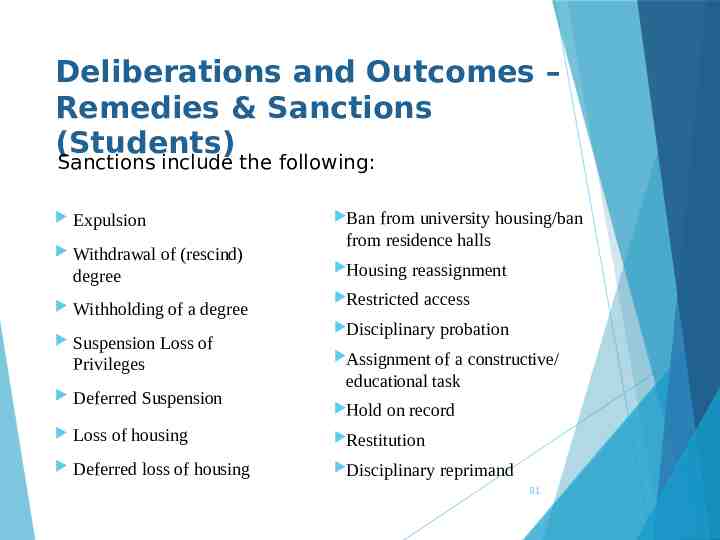
Deliberations and Outcomes – Remedies & Sanctions (Students) Sanctions include the following: Expulsion Ban Withdrawal of (rescind) degree Housing Withholding of a degree Suspension Loss of Privileges from university housing/ban from residence halls reassignment Restricted access Disciplinary probation Assignment of a constructive/ educational task Deferred Suspension Loss of housing Restitution Deferred loss of housing Disciplinary Hold on record reprimand 81
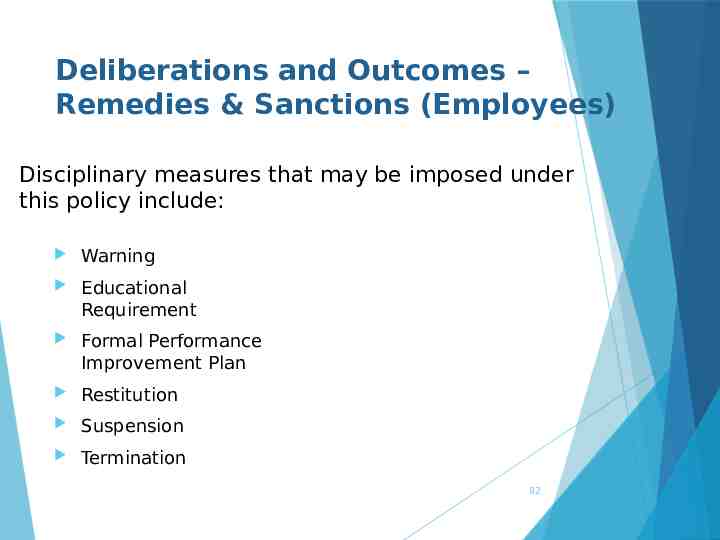
Deliberations and Outcomes – Remedies & Sanctions (Employees) Disciplinary measures that may be imposed under this policy include: Warning Educational Requirement Formal Performance Improvement Plan Restitution Suspension Termination 82
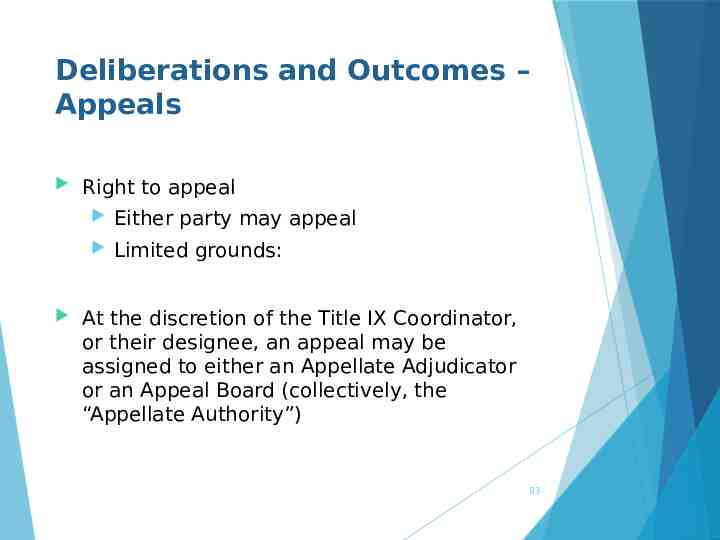
Deliberations and Outcomes – Appeals Right to appeal Either party may appeal Limited grounds: At the discretion of the Title IX Coordinator, or their designee, an appeal may be assigned to either an Appellate Adjudicator or an Appeal Board (collectively, the “Appellate Authority”) 83
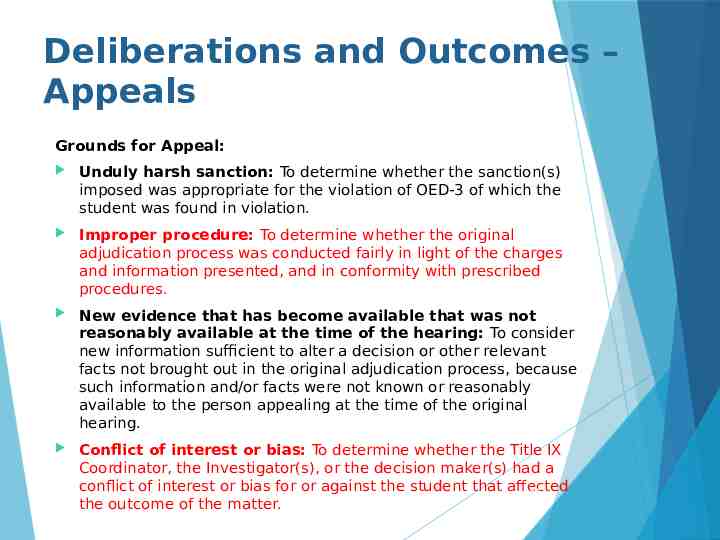
Deliberations and Outcomes – Appeals Grounds for Appeal: Unduly harsh sanction: To determine whether the sanction(s) imposed was appropriate for the violation of OED-3 of which the student was found in violation. Improper procedure: To determine whether the original adjudication process was conducted fairly in light of the charges and information presented, and in conformity with prescribed procedures. New evidence that has become available that was not reasonably available at the time of the hearing: To consider new information sufficient to alter a decision or other relevant facts not brought out in the original adjudication process, because such information and/or facts were not known or reasonably available to the person appealing at the time of the original hearing. Conflict of interest or bias: To determine whether the Title IX Coordinator, the Investigator(s), or the decision maker(s) had a conflict of interest or bias for or against the student that affected 84 the outcome of the matter.

Before we close Questions? 85

